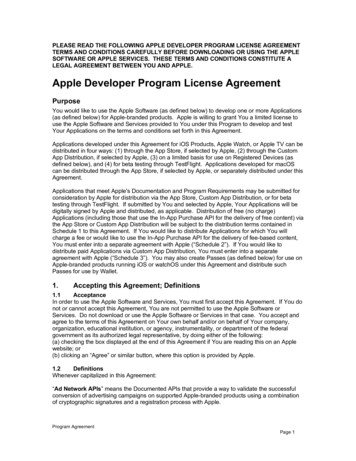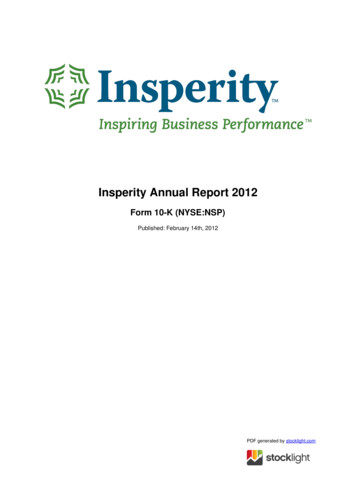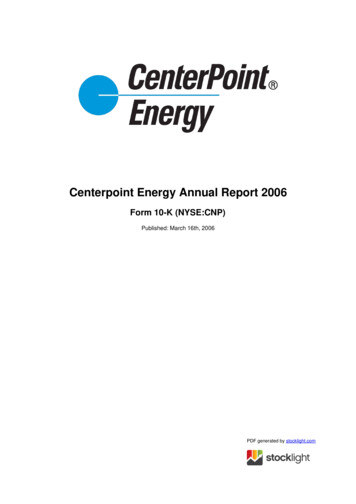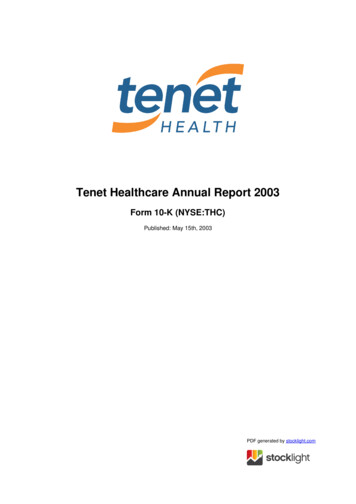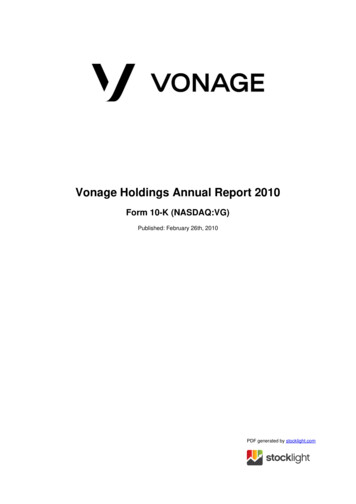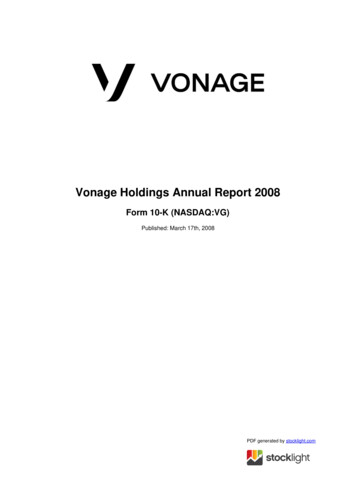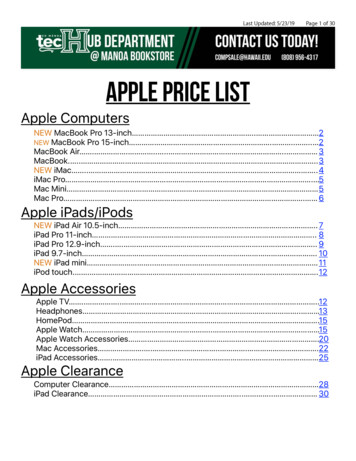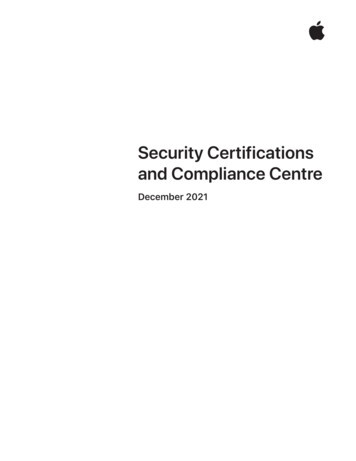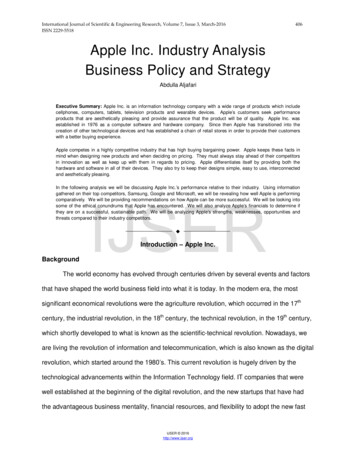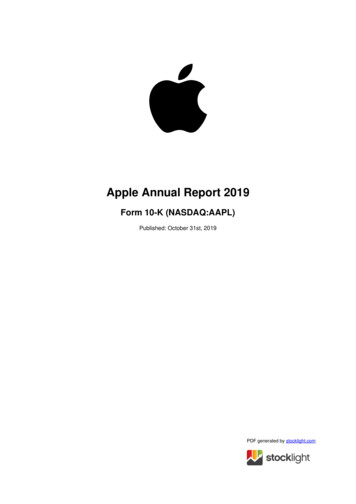
Transcription
Apple Annual Report 2019Form 10-K (NASDAQ:AAPL)Published: October 31st, 2019PDF generated by stocklight.com
UNITED STATESSECURITIES AND EXCHANGE COMMISSIONWashington, D.C. 20549FORM 10-K(Mark One) ANNUAL REPORT PURSUANT TO SECTION 13 OR 15(d) OF THE SECURITIES EXCHANGE ACT OF 1934For the fiscal year ended September 28, 2019or TRANSITION REPORT PURSUANT TO SECTION 13 OR 15(d) OF THE SECURITIES EXCHANGE ACT OF 1934For the transition period fromtoCommission File Number: 001-36743.Apple Inc.(Exact name of Registrant as specified in its charter)California94-2404110(State or other jurisdictionof incorporation or organization)(I.R.S. Employer Identification No.)One Apple Park WayCupertinoCalifornia95014(Address of principal executive offices)(Zip Code)(408) 996-1010(Registrant’s telephone number, including area code)Securities registered pursuant to Section 12(b) of the Act:Title of each classTradingsymbol(s)Name of each exchange on which registeredCommon Stock, 0.00001 par value per share1.000% Notes due 20221.375% Notes due 20240.875% Notes due 20251.625% Notes due 20262.000% Notes due 20271.375% Notes due 20293.050% Notes due 20293.600% Notes due 2042AAPL————————The Nasdaq Stock Market LLCThe Nasdaq Stock Market LLCThe Nasdaq Stock Market LLCThe Nasdaq Stock Market LLCThe Nasdaq Stock Market LLCThe Nasdaq Stock Market LLCThe Nasdaq Stock Market LLCThe Nasdaq Stock Market LLCThe Nasdaq Stock Market LLCSecurities registered pursuant to Section 12(g) of the Act: NoneIndicate by check mark if the Registrant is a well-known seasoned issuer, as defined in Rule 405 of the Securities Act.Yes No Indicate by check mark if the Registrant is not required to file reports pursuant to Section 13 or Section 15(d) of the Act.Yes No Indicate by check mark whether the Registrant (1) has filed all reports required to be filed by Section 13 or 15(d) of the Securities Exchange Act of 1934 during the preceding 12months (or for such shorter period that the Registrant was required to file such reports), and (2) has been subject to such filing requirements for the past 90 days.Yes No Indicate by check mark whether the Registrant has submitted electronically every Interactive Data File required to be submitted pursuant to Rule 405 of Regulation S-T (§232.405 ofthis chapter) during the preceding 12 months (or for such shorter period that the Registrant was required to submit such files).Yes No Indicate by check mark whether the Registrant is a large accelerated filer, an accelerated filer, a non-accelerated filer, a smaller reporting company, or an emerging growth company.See the definitions of “large accelerated filer,” “accelerated filer,” “smaller reporting company,” and “emerging growth company” in Rule 12b-2 of the Exchange Act.Large accelerated filer Accelerated filer Non-accelerated filer Smaller reporting company Emerging growth company If an emerging growth company, indicate by check mark if the Registrant has elected not to use the extended transition period for complying with any new or revised financialaccounting standards provided pursuant to Section 13(a) of the Exchange Act. Indicate by check mark whether the Registrant is a shell company (as defined in Rule 12b-2 of the Act).Yes No The aggregate market value of the voting and non-voting stock held by non-affiliates of the Registrant, as of March 29, 2019, the last business day of the Registrant’s most recentlycompleted second fiscal quarter, was approximately 874,698,000,000. Solely for purposes of this disclosure, shares of common stock held by executive officers and directors of the
Registrant as of such date have been excluded because such persons may be deemed to be affiliates. This determination of executive officers and directors as affiliates is notnecessarily a conclusive determination for any other purposes.4,443,265,000 shares of common stock were issued and outstanding as of October 18, 2019.DOCUMENTS INCORPORATED BY REFERENCEPortions of the Registrant’s definitive proxy statement relating to its 2020 annual meeting of shareholders (the “2020 Proxy Statement”) are incorporated by reference into Part III ofthis Annual Report on Form 10-K where indicated. The 2020 Proxy Statement will be filed with the U.S. Securities and Exchange Commission within 120 days after the end of thefiscal year to which this report relates.
Apple Inc.Form 10-KFor the Fiscal Year Ended September 28, 2019TABLE OF CONTENTSPagePart IItem 1.Item 1A.Item 1B.Item 2.Item 3.Item 4.Item 5.Item 6.Item 7.Item 7A.Item 8.Item 9.Item 9A.Item 9B.Item 10.Item 11.Item 12.Item 13.Item 14.Item 15.Item 16.BusinessRisk FactorsUnresolved Staff CommentsPropertiesLegal ProceedingsMine Safety DisclosuresPart IIMarket for Registrant’s Common Equity, Related Stockholder Matters and Issuer Purchases of Equity SecuritiesSelected Financial DataManagement’s Discussion and Analysis of Financial Condition and Results of OperationsQuantitative and Qualitative Disclosures About Market RiskFinancial Statements and Supplementary DataChanges in and Disagreements with Accountants on Accounting and Financial DisclosureControls and ProceduresOther InformationPart IIIDirectors, Executive Officers and Corporate GovernanceExecutive CompensationSecurity Ownership of Certain Beneficial Owners and Management and Related Stockholder MattersCertain Relationships and Related Transactions, and Director IndependencePrincipal Accounting Fees and ServicesPart IVExhibits, Financial Statement SchedulesForm 10-K Summary1514141414151718262859595960606060606163
This Annual Report on Form 10-K (“Form 10-K”) contains forward-looking statements, within the meaning of the Private Securities Litigation Reform Act of 1995, thatinvolve risks and uncertainties. Many of the forward-looking statements are located in Part II, Item 7 of this Form 10-K under the heading “Management’s Discussionand Analysis of Financial Condition and Results of Operations.” Forward-looking statements provide current expectations of future events based on certainassumptions and include any statement that does not directly relate to any historical or current fact. Forward-looking statements can also be identified by words suchas “future,” “anticipates,” “believes,” “estimates,” “expects,” “intends,” “plans,” “predicts,” “will,” “would,” “could,” “can,” “may,” and similar terms. Forward-lookingstatements are not guarantees of future performance and the Company’s actual results may differ significantly from the results discussed in the forward-lookingstatements. Factors that might cause such differences include, but are not limited to, those discussed in Part I, Item 1A of this Form 10-K under the heading “RiskFactors,” which are incorporated herein by reference. Unless otherwise stated, all information presented herein is based on the Company’s fiscal calendar, andreferences to particular years, quarters, months or periods refer to the Company’s fiscal years ended in September and the associated quarters, months and periodsof those fiscal years. Each of the terms the “Company” and “Apple” as used herein refers collectively to Apple Inc. and its wholly owned subsidiaries, unless otherwisestated. The Company assumes no obligation to revise or update any forward-looking statements for any reason, except as required by law.PART IItem 1.BusinessCompany BackgroundThe Company designs, manufactures and markets smartphones, personal computers, tablets, wearables and accessories, and sells a variety of related services. TheCompany’s fiscal year is the 52- or 53-week period that ends on the last Saturday of September. The Company is a California corporation established in 1977.ProductsiPhoneiPhone is the Company’s line of smartphones based on its iOS operating system. In September 2019, the Company introduced three new iPhones: iPhone 11,iPhone 11 Pro and iPhone 11 Pro Max.MacMac is the Company’s line of personal computers based on its macOS operating system. During 2019, the Company released a new version of MacBook Air anda new Mac mini , and introduced an updated Mac Pro , which is expected to be available in the fall of 2019.iPadiPad is the Company’s line of multi-purpose tablets. iPad is based on the Company’s iPadOS operating system, which was introduced during 2019. Also during2019, the Company released two new versions of iPad Pro , an iPad Air , an updated iPad mini and a new 10.2-inch iPad.Wearables, Home and AccessoriesWearables, Home and Accessories includes AirPods , Apple TV , Apple Watch , Beats products, HomePod , iPod touch and other Apple-branded and thirdparty accessories. AirPods are the Company’s wireless headphones that interact with Siri. In October 2019, the Company introduced AirPods Pro . Apple Watch is apersonal electronic device that combines the watchOS user interface and other technologies created specifically for a smaller device. In September 2019, theCompany introduced Apple Watch Series 5.ServicesDigital Content Stores and Streaming ServicesThe Company operates various platforms that allow customers to discover and download applications and digital content, such as books, music, video, games andpodcasts. These platforms include the App Store , available for iPhone and iPad, the Mac App Store, the TV App Store and the Watch App Store.The Company also offers subscription-based digital content streaming services, including Apple Music , which offers users a curated listening experience with ondemand radio stations, and Apple TV , which offers exclusive original content, and is expected to be available in November 2019.
AppleCareAppleCare includes AppleCare (“AC ”) and the AppleCare Protection Plan, which are fee-based services that extend the coverage of phone support eligibility andhardware repairs. AC offers additional coverage for instances of accidental damage and is available in certain countries for certain products. Additionally, AC withtheft and loss protection is available for iPhone in the U.S.iCloudiCloud is the Company’s cloud service, which stores music, photos, contacts, calendars, mail, documents and more, keeping them up-to-date and available acrossmultiple Apple devices and Windows personal computers.LicensingThe Company licenses the use of certain of its intellectual property, and provides other related services.Other ServicesThe Company delivers a variety of other services available in certain countries, including Apple Arcade , a game subscription service; Apple Card , a co-brandedcredit card; Apple News , a subscription news and magazine service; and Apple Pay, a cashless payment service.Markets and DistributionThe Company’s customers are primarily in the consumer, small and mid-sized business, education, enterprise and government markets. The Company sells itsproducts and resells third-party products in most of its major markets directly to consumers, small and mid-sized businesses, and education, enterprise andgovernment customers through its retail and online stores and its direct sales force. The Company also employs a variety of indirect distribution channels, such asthird-party cellular network carriers, wholesalers, retailers and resellers. During 2019, the Company’s net sales through its direct and indirect distribution channelsaccounted for 31% and 69%, respectively, of total net sales.No single customer accounted for more than 10% of net sales in2019, 2018 and 2017.CompetitionThe markets for the Company’s products and services are highly competitive and the Company is confronted by aggressive competition in all areas of its business.These markets are characterized by frequent product introductions and rapid technological advances that have substantially increased the capabilities and use ofsmartphones, personal computers, tablets and other electronic devices. Many of the Company’s competitors that sell mobile devices and personal computers basedon other operating systems seek to compete primarily through aggressive pricing and very low cost structures. Principal competitive factors important to the Companyinclude price, product and service features (including security features), relative price and performance, product and service quality and reliability, design innovation, astrong third-party software and accessories ecosystem, marketing and distribution capability, service and support, and corporate reputation.The Company is focused on expanding its market opportunities related to smartphones, personal computers, tablets and other electronic devices. These markets arehighly competitive and include many large, well-funded and experienced participants. The Company expects competition in these markets to intensify significantly ascompetitors imitate features of the Company’s products and applications within their products, or collaborate to offer solutions that are more competitive than thosethey currently offer. These markets are characterized by aggressive price competition, frequent product introductions, evolving design approaches and technologies,rapid adoption of technological advancements by competitors, and price sensitivity on the part of consumers and businesses.The Company’s services also face substantial competition, including from companies that have significant resources and experience and have established serviceofferings with large customer bases. The Company competes with business models that provide content to users for free. The Company also competes withillegitimate means to obtain third-party digital content and applications.The Company believes it offers superior innovation and integration of the entire solution, including hardware, software and services. Some of the Company’s currentand potential competitors have substantial resources and may be able to provide such products and services at little or no profit, or even at a loss, to compete with theCompany’s offerings.
Supply of ComponentsAlthough most components essential to the Company’s business are generally available from multiple sources, certain components are currently obtained from singleor limited sources. The Company also competes for various components with other participants in the markets for smartphones, personal computers, tablets andother electronic devices. Therefore, many components used by the Company, including those that are available from multiple sources, are at times subject toindustry-wide shortage and significant commodity pricing fluctuations.The Company uses some custom components that are not commonly used by its competitors, and new products introduced by the Company often utilize customcomponents available from only one source. When a component or product uses new technologies, initial capacity constraints may exist until the suppliers’ yieldshave matured or their manufacturing capacities have increased. The continued availability of these components at acceptable prices, or at all, may be affected ifsuppliers decide to concentrate on the production of common components instead of components customized to meet the Company’s requirements.The Company has entered into agreements for the supply of many components; however, there can be no guarantee that the Company will be able to extend orrenew these agreements on similar terms, or at all.Substantially all of the Company’s hardware products are manufactured by outsourcing partners that are located primarily in Asia, with some Mac computersmanufactured in the U.S. and Ireland.Research and DevelopmentBecause the industries in which the Company competes are characterized by rapid technological advances, the Company’s ability to compete successfully dependsheavily upon its ability to ensure a continual and timely flow of competitive products, services and technologies to the marketplace. The Company continues todevelop new technologies to enhance existing products and services, and to expand the range of its offerings through research and development (“R&D”), licensing ofintellectual property and acquisition of third-party businesses and technology.Intellectual PropertyThe Company currently holds a broad collection of intellectual property rights relating to certain aspects of its hardware devices, accessories, software and services.This includes patents, copyrights, trademarks, service marks, trade dress and other forms of intellectual property rights in the U.S. and various foreign countries.Although the Company believes the ownership of such intellectual property rights is an important factor in its business and that its success does depend in part onsuch ownership, the Company relies primarily on the innovative skills, technical competence and marketing abilities of its personnel.The Company regularly files patent applications to protect innovations arising from its research, development and design, and is currently pursuing thousands ofpatent applications around the world. Over time, the Company has accumulated a large portfolio of issued patents, including utility patents, design patents and others.The Company also holds copyrights relating to certain aspects of its products and services. No single intellectual property right is solely responsible for protecting theCompany’s products. The Company believes the duration of its intellectual property rights is adequate relative to the expected lives of its products.In addition to Company-owned intellectual property, many of the Company’s products and services are designed to include intellectual property owned by third parties.It may be necessary in the future to seek or renew licenses relating to various aspects of the Company’s products, processes and services. While the Company hasgenerally been able to obtain such licenses on commercially reasonable terms in the past, there is no guarantee that such licenses could be obtained in the future onreasonable terms or at all.Business Seasonality and Product IntroductionsThe Company has historically experienced higher net sales in its first quarter compared to other quarters in its fiscal year due in part to seasonal holiday demand.Additionally, new product and service introductions can significantly impact net sales, cost of sales and operating expenses. The timing of product introductions canalso impact the Company’s net sales to its indirect distribution channels as these channels are filled with new inventory following a product launch, and channelinventory of an older product often declines as the launch of a newer product approaches. Net sales can also be affected when consumers and distributors anticipatea product introduction.EmployeesAs of September 28, 2019, the Company had approximately 137,000 full-time equivalent employees.
Available InformationThe Company’s Annual Reports on Form 10-K, Quarterly Reports on Form 10-Q, Current Reports on Form 8-K, and amendments to reports filed pursuant to Sections13(a) and 15(d) of the Securities Exchange Act of 1934, as amended (the “Exchange Act”), are filed with the Securities and Exchange Commission (the “SEC”). TheCompany is subject to the informational requirements of the Exchange Act and files or furnishes reports, proxy statements and other information with the SEC. Suchreports and other information filed by the Company with the SEC are available free of charge at /default.aspx whensuch reports are available on the SEC’s website. The SEC maintains an Internet site that contains reports, proxy and information statements, and other informationregarding issuers that file electronically with the SEC at www.sec.gov. The Company periodically provides other information for investors on its corporate website,www.apple.com, and its investor relations website, investor.apple.com. This includes press releases and other information about financial performance, information oncorporate governance and details related to the Company’s annual meeting of shareholders. The information contained on the websites referenced in this Form 10-Kis not incorporated by reference into this filing. Further, the Company’s references to website URLs are intended to be inactive textual references only.
Item 1A.RiskFactorsThe following discussion of risk factors contains forward-looking statements. These risk factors may be important to understanding other statements in this Form 10-K.The following information should be read in conjunction with Part II, Item 7, “Management’s Discussion and Analysis of Financial Condition and Results of Operations”and the consolidated financial statements and accompanying notes in Part II, Item 8, “Financial Statements and Supplementary Data” of this Form 10-K.The business, financial condition and operating results of the Company can be affected by a number of factors, whether currently known or unknown, including butnot limited to those described below, any one or more of which could, directly or indirectly, cause the Company’s actual financial condition and operating results tovary materially from past, or from anticipated future, financial condition and operating results. Any of these factors, in whole or in part, could materially and adverselyaffect the Company’s business, financial condition, operating results and stock price.Because of the following factors, as well as other factors affecting the Company’s financial condition and operating results, past financial performance should not beconsidered to be a reliable indicator of future performance, and investors should not use historical trends to anticipate results or trends in future periods.Global and regional economic conditions could materially adversely affect the Company’s business, results of operations, financial condition and growth.The Company has international operations with sales outside the U.S. representing a majority of the Company’s total net sales. In addition, a majority of theCompany’s supply chain, and its manufacturing and assembly activities, are located outside the U.S. As a result, the Company’s operations and performance dependsignificantly on global and regional economic conditions.Adverse macroeconomic conditions, including inflation, slower growth or recession, new or increased tariffs, changes to fiscal and monetary policy, tighter credit,higher interest rates, high unemployment and currency fluctuations could materially adversely affect demand for the Company’s products and services. In addition,consumer confidence and spending could be adversely affected in response to financial market volatility, negative financial news, conditions in the real estate andmortgage markets, declines in income or asset values, changes to fuel and other energy costs, labor and healthcare costs and other economic factors.In addition to an adverse impact on demand for the Company’s products, uncertainty about, or a decline in, global or regional economic conditions could have asignificant impact on the Company’s suppliers, contract manufacturers, logistics providers, distributors, cellular network carriers and other channel partners. Potentialeffects include financial instability; inability to obtain credit to finance operations and purchases of the Company’s products; and insolvency.A downturn in the economic environment could also lead to increased credit and collectibility risk on the Company’s trade receivables; the failure of derivativecounterparties and other financial institutions; limitations on the Company’s ability to issue new debt; reduced liquidity; and declines in the fair value of the Company’sfinancial instruments. These and other economic factors could materially adversely affect the Company’s business, results of operations, financial condition andgrowth.Global markets for the Company’s products and services are highly competitive and subject to rapid technological change, and the Company may beunable to compete effectively in these markets.The Company’s products and services are offered in highly competitive global markets characterized by aggressive price competition and resulting downwardpressure on gross margins, frequent introduction of new products and services, short product life cycles, evolving industry standards, continual improvement inproduct price/performance characteristics, rapid adoption of technological advancements by competitors, and price sensitivity on the part of consumers andbusinesses.The Company’s ability to compete successfully depends heavily on its ability to ensure a continuing and timely introduction of innovative new products, services andtechnologies to the marketplace. The Company believes it is unique in that it designs and develops nearly the entire solution for its products, including the hardware,operating system, numerous software applications and related services. As a result, the Company must make significant investments in R&D. There can be noassurance that these investments will achieve expected returns, and the Company may not be able to develop and market new products and services successfully.The Company currently holds a significant number of patents, trademarks and copyrights and has registered, and applied to register, numerous patents, trademarksand copyrights. In contrast, many of the Company’s competitors seek to compete primarily through aggressive pricing and very low cost structures, and emulating theCompany’s products and infringing on its intellectual property. If the Company is unable to continue to develop and sell innovative new products with attractivemargins or if competitors infringe on the Company’s intellectual property, the Company’s ability to maintain a competitive advantage could be adversely affected.
The Company has a minority market share in the global smartphone, personal computer and tablet markets. The Company faces substantial competition in thesemarkets from companies that have significant technical, marketing, distribution and other resources, as well as established hardware, software and digital contentsupplier relationships. In addition, some of the Company’s competitors have broader product lines, lower-priced products and a larger installed base of active devices.Competition has been particularly intense as competitors have aggressively cut prices and lowered product margins. Certain competitors may have the resources,experience or cost structures to provide products at little or no profit or even at a loss.Additionally, the Company faces significant competition as competitors imitate the Company’s product features and applications within their products or collaborate tooffer solutions that are more competitive than those they currently offer. The Company also expects competition to intensify as competitors imitate the Company’sapproach to providing components seamlessly within their offerings or work collaboratively to offer integrated solutions.Some of the markets in which the Company competes have from time to time experienced little to no growth or contracted. In addition, an increasing number ofInternet-enabled devices that include software applications and are smaller, simpler and cheaper than traditional personal computers compete with some of theCompany’s existing products.The Company’s services also face substantial competition, including from companies that have significant resources and experience and have established serviceofferings with large customer bases. The Company competes with business models that provide content to users for free. The Company also competes withillegitimate means to obtain third-party digital content and applications.The Company’s financial condition and operating results depend substantially on the Company’s ability to continually improve its products and services to maintaintheir functional and design advantages. There can be no assurance the Company will be able to continue to provide products and services that compete effectively.To remain competitive and stimulate customer demand, the Company must successfully manage frequent introductions and transitions of products andservices.Due to the highly volatile and competitive nature of the industries in which the Company competes, the Company must continually introduce new products, servicesand technologies, enhance existing products and services, effectively stimulate customer demand for new and upgraded products and services, and successfullymanage the transition to these new and upgraded products and services. The success of new product and service introductions depends on a number of factorsincluding, but not limited to, timely and successful development, market acceptance, the Company’s ability to manage the risks associated with new productproduction ramp-up issues, the availability of application software for new products, the effective management of purchase commitments and inventory levels in linewith anticipated product demand, the availability of products in appropriate quantities and at expected costs to meet anticipated demand, and the risk that newproducts and services may have quality or other defects or deficiencies. Accordingly, the Company cannot determine in advance the ultimate effect of new productand service introductions and transitions.The Company depends on the performance of carriers, wholesalers, retailers and other resellers.The Company distributes its products through cellular network carriers, wholesalers, retailers and resellers, many of whom distribute products from competingmanufacturers. The Company also sells its products and resells third-party products in most of its major markets directly to consumers, small and mid-sizedbusinesses, and education, enterprise and government customers through its retail and online stores and its direct sales force.Some carriers providing cellular network service for iPhone offer financing, installment payment plans or subsidies for users’ purchases of the device. There is noassurance that such offers will be continued at all or in the same amounts upon renewal of the Company’s agreements with these carriers or in agreements theCompany enters into with new carriers.The Company has inve
UNITED STATES SECURITIES AND EXCHANGE COMMISSION Washington, D.C. 20549 FORM 10-K (Mark One) ANNUAL REPORT PURSUANT TO SECTION 13 OR 15(d) OF THE SECURITIES EXCHANGE ACT OF 1934 For the fiscal year endedSeptember 28, 2019 or TRANSITION REPORT PURSUANT TO SECTION 13 OR 15(d) OF THE SECURITIES EXCHANGE ACT OF 1934 For the transition period from to .
